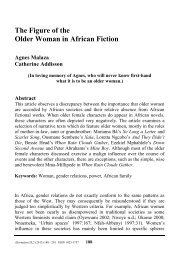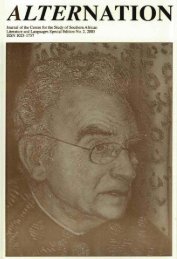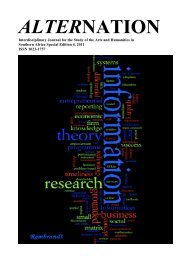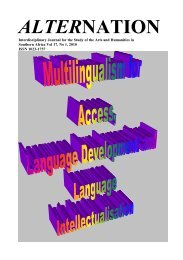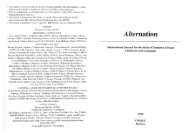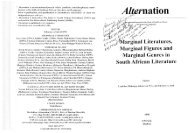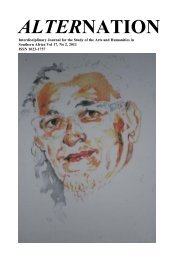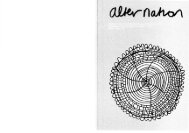Shane Moran - Alternation Journal
Shane Moran - Alternation Journal
Shane Moran - Alternation Journal
You also want an ePaper? Increase the reach of your titles
YUMPU automatically turns print PDFs into web optimized ePapers that Google loves.
postinodernism:<br />
. . . what is post-modern in the rest of the world use to be called magic realist g of fiction and reality, Nico],<br />
in South America and still goes by that name in Canada (Lernout in Zamora vel. Here the reader witnesses<br />
1995 : 194)'. Enoch Mistas-the figure of<br />
This Day And Age exhibits characteristics associated with post-modemist<br />
particularly the way the text draws attention to its own structure. Nic It gross iniquities here.<br />
in demonstrating the writing process as a constant and parasitic referen<br />
shaped by socio-historical process. The notion of the 'ex-centri<br />
speaking from the margin, from a place 'other', is an essential feature of that stra<br />
postinodernism called magic realism. Nicol questions the traditional bound<br />
between genres, while revealing the dynamics around the process ofwriting to poin<br />
that there are no privileged centres of culture, race, or politics.<br />
The novel starts by appropriating the techniques of historical<br />
documentary realism and uses them to create an alternative world to existing rea<br />
The 'Prologue' is siinply a quotation from other texts that anticipat interpretations; on the one<br />
what is to follow. By choosing to introduce his text in this fashion, Tasmaine because he is a<br />
shows the reader that writing involves a constant reference to the already existing t low him to commit sucl, a<br />
This tends to 'deconstruct' the notion of an author as an originator, an inventor ot make love because they<br />
imaginative genius, which makes him/ her unique. The process of s<br />
ndecidable and this reader<br />
continues in the following section of the novel entitled 'Afterwards'.<br />
reader is given the whole plot of the novel and the circumstances that surround<br />
theme:<br />
Between the time that was before and the time that came aftelwards there<br />
hung a brutal moment (Nicol 1992:3).<br />
Brutal moments characterise this novel. The reader witnesses cha<br />
(and sometiines contradictory) ofworld-views, and this disjunctiv<br />
made clear from the onset:<br />
An ear for this. An ear for that. Who to believe? Who to trust? On the one<br />
hand. On the other hand. My story. History. The struggle for truth continues<br />
afterwards (Nicol 1992:3).<br />
But is this really a narrative strategy, or does this novel move towards reje<br />
narrativity altogether? Is it even (i1n)possible to narrate the end of narration?<br />
consequence of defamiliarising narrativity is the problematisatio<br />
history as a 'true' reflection of reality. Instead, history is viewed as a<br />
manipulative discourse that, as exemplified by Elloch Mistas in<br />
Zamora, L,P & WB Fans (eds) 1995 Theory, History, Conzr~iunrty London nuke lJniv<br />
Press



